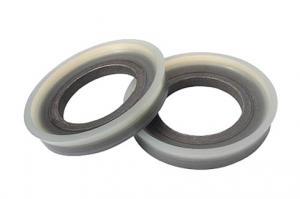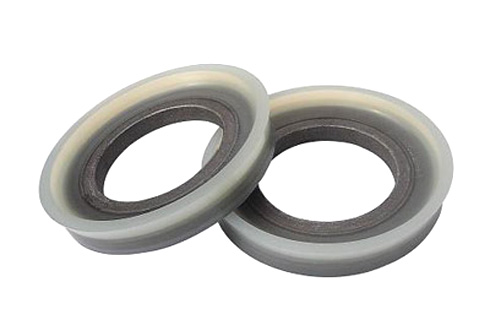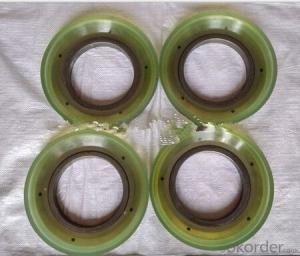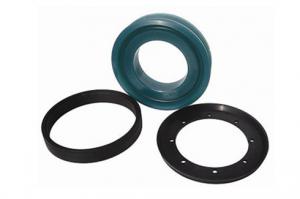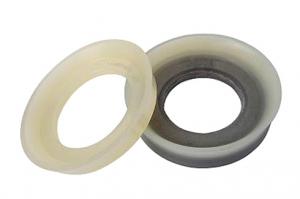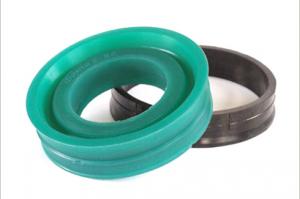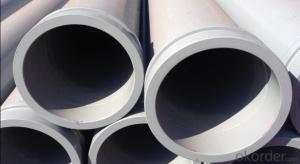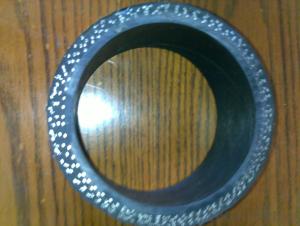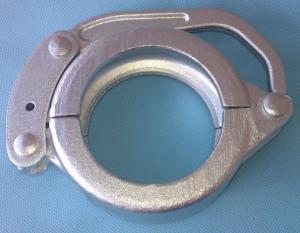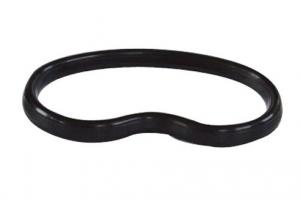Concrete Pump Kyokuto Seal Piston DN205 &- DN225
- Loading Port:
- China Main Port
- Payment Terms:
- TT OR LC
- Min Order Qty:
- -
- Supply Capability:
- -
OKorder Service Pledge
Quality Product, Order Online Tracking, Timely Delivery
OKorder Financial Service
Credit Rating, Credit Services, Credit Purchasing
You Might Also Like
Brand: Schwing, Putzmeister, Sany,Zoomlion, IHI, Kyokuto, Sermac
Other products:
1) ST52 steel pipe, elbow, reducer
2) Wear-resisting board and Cuts ink
3) Coupling and seal ring for Putzmeister,Schwing, Sany
4) Rubber hose
5) Cleaning series and others
- Q: How often should concrete pump hydraulic filters be inspected and replaced?
- Concrete pump hydraulic filters should be inspected on a regular basis, ideally at least once every three months. However, the frequency of inspection and replacement may vary depending on the specific conditions and usage of the concrete pump. If the pump is operating in particularly harsh environments or is being used extensively, more frequent inspections and replacements may be necessary. It is important to monitor the condition of the hydraulic filters closely and replace them whenever they become clogged, damaged or worn out. Neglecting to inspect and replace the filters as needed can result in decreased performance and efficiency of the concrete pump, as well as potential damage to the hydraulic system.
- Q: Are there any specific guidelines for the installation of pistons or cylinders in concrete pump spare parts?
- Yes, there are specific guidelines for the installation of pistons or cylinders in concrete pump spare parts. It is important to follow manufacturer instructions and recommendations for proper alignment, lubrication, and torque specifications during installation. Additionally, regular inspection and maintenance are crucial to ensure optimal performance and longevity of the pump parts.
- Q: How do I properly maintain and replace hydraulic hoses in concrete pump spare parts?
- To ensure the smooth functioning and longevity of your equipment, it is crucial to properly maintain and replace hydraulic hoses in concrete pump spare parts. Here are some effective steps you can take: 1. Conduct regular visual inspections to identify any signs of wear, damage, or leaks. Look for bulges, cracks, abrasions, or fraying. Pay attention to fittings, connections, and bends in the hose. 2. Implement a preventive maintenance schedule to reduce the chances of unexpected hose failure. Clean the hoses regularly to remove dirt, debris, and concrete residues that may cause abrasion or clogging. Use a mild detergent and water, and ensure thorough drying. 3. Store hydraulic hoses in a clean, dry, and temperature-controlled environment when not in use. Protect them from direct sunlight, extreme temperatures, and chemicals to avoid degradation. 4. Handle hydraulic hoses with care to prevent damage. Avoid dragging them on rough surfaces or sharp edges that can cause cuts or abrasions. Minimize excessive kinking or twisting, as it weakens the internal structure. 5. Replace hydraulic hoses promptly upon noticing signs of wear, damage, or leaks. Do not wait for hose failure, as it can lead to costly downtime and safety hazards. Follow the manufacturer's recommendations for replacement intervals. 6. Use high-quality replacement hoses that are compatible with your concrete pump. Choose hoses that meet industry standards and specifications for durability in concrete pumping conditions. 7. Properly install replacement hoses, ensuring correct routing and secure connections to fittings. Use appropriate tools and techniques to tighten fittings, avoiding over-tightening that can damage the hose or fittings. 8. Provide regular training to your staff on proper maintenance, inspection, and replacement procedures for hydraulic hoses. This will enhance their knowledge and skills, reducing the risks of improper handling or installation. By following these steps, you can effectively maintain and replace hydraulic hoses in concrete pump spare parts, ensuring the safety and efficiency of your equipment. Always refer to the manufacturer's guidelines and seek professional assistance when needed.
- Q: How can one identify the correct part number for a specific concrete pump spare part?
- To identify the correct part number for a specific concrete pump spare part, one can start by examining the equipment's manual or documentation. These resources usually provide detailed information about the pump's components, including part numbers. If the manual is unavailable, contacting the manufacturer or a reputable supplier of concrete pump parts can also be helpful. Providing them with the necessary details, such as the make, model, and serial number of the pump, will assist them in identifying and providing the correct part number for the required spare part.
- Q: What are the most commonly replaced spare parts for concrete pumps?
- Concrete pumps commonly require the replacement of certain spare parts. These parts, including wear plates, wear rings, and delivery cylinders, are prone to constant abrasion and wear. This is a result of the high pressures and velocities involved in the movement of concrete. Wear plates, usually made from hardened steel, are installed in high-wear areas such as the hopper to protect against the abrasive nature of concrete. On the other hand, wear rings, made from durable materials like polyurethane, are utilized to minimize friction between the piston and cylinder, thereby reducing wear and maintaining optimal performance. Additionally, delivery cylinders, also known as pumping cylinders, play a crucial role in transferring concrete from the hopper to the discharge outlet. Over time, the interior surface of the cylinder may experience wear or damage, necessitating replacement to ensure efficient concrete flow. Other commonly replaced spare parts include pistons, seals, hydraulic hoses, and couplings. These components, too, undergo wear and tear during the pumping process. It is essential to regularly inspect and maintain these parts to prevent unexpected equipment downtime and ensure the long-term reliability and performance of concrete pumps.
- Q: What is the role of a concrete pump hopper agitator blade?
- The role of a concrete pump hopper agitator blade is to ensure the consistency and flow of the concrete while it is being pumped. The agitator blade is designed to mix the concrete in the hopper, preventing it from settling or becoming too thick. By continuously stirring the concrete, the agitator blade helps to maintain its proper consistency, making it easier to pump and ensuring a more uniform distribution of the material. This is particularly important when working with large volumes of concrete or when pumping over long distances, as it helps to prevent blockages and maintain a smooth and efficient pumping process. Overall, the agitator blade plays a crucial role in the successful operation of a concrete pump, ensuring that the concrete remains in a workable state throughout the pumping process.
- Q: What are the different types of concrete pump rubber hoses?
- In the market, you can find a variety of concrete pump rubber hoses. These hoses come in different types to cater to specific needs. The first type is the Steel Wire Reinforced Hose, which is the most commonly used. It is built with multiple layers of steel wire to provide maximum strength and durability. This type of hose is suitable for high-pressure applications and can handle the heavy pumping of concrete effortlessly. Another type is the Textile Reinforced Hose, which is reinforced with multiple layers of textile fabric like nylon or polyester. These hoses are lighter in weight compared to the steel wire reinforced ones, making them easier to handle and maneuver. They are suitable for medium-pressure applications and are commonly used in smaller concrete pumps. Then there is the Fabric Hose, which is made from a single layer of fabric like nylon or polyester. These hoses are lightweight and flexible, making them easy to handle and transport. Fabric hoses are suitable for low-pressure applications and are commonly used in small-scale construction projects. Composite Hoses are made from a combination of different materials such as rubber and plastic. These hoses are lightweight and highly flexible, which makes them ideal for applications where maneuverability is crucial. They are commonly used in smaller concrete pumps and can handle both low and medium pressure. Lastly, there are Flanged Hoses, which have flanges attached at both ends. These flanges are used to connect the hose to the pump and the nozzle, providing a secure connection and preventing any leaks or disconnections during the pumping process. Flanged hoses are commonly used in high-pressure applications and are suitable for large-scale construction projects. In conclusion, the choice of concrete pump rubber hose depends on specific project requirements. Factors such as pressure, size, and type of concrete being pumped should be considered to ensure efficient and safe concrete pumping operations.
- Q: Can concrete pump spare parts be purchased online?
- Yes, concrete pump spare parts can be purchased online. There are various online platforms and websites that specialize in selling construction equipment and spare parts, including concrete pump spare parts. These online stores offer a wide range of options and brands, allowing customers to browse and select the specific spare parts they need for their concrete pump. Additionally, online purchasing provides the convenience of comparing prices, reading customer reviews, and having the spare parts delivered to your doorstep. However, it is essential to ensure the authenticity and reliability of the online store before making a purchase to ensure that you are getting genuine and high-quality spare parts.
- Q: How to judge the concrete pipeline blockage?
- When the conveying pressure increases gradually, while the material level of the hopper does not fall, the pipe outlet is not out of stock, the pump vibrates, and the pipe is accompanied by strong vibration and displacement, the pipe blockage can be determined.
- Q: What are the advantages of using stainless steel components in concrete pump spare parts?
- There are several advantages of using stainless steel components in concrete pump spare parts. Firstly, stainless steel has excellent corrosion resistance, which ensures the longevity and durability of the spare parts even in harsh environments. Secondly, stainless steel is known for its high strength-to-weight ratio, providing increased strength and reliability without adding excessive weight to the concrete pump. Additionally, stainless steel is highly resistant to wear and tear, which reduces the need for frequent replacements and maintenance. Lastly, stainless steel components offer a hygienic and clean surface, making them suitable for applications in the construction industry where cleanliness is crucial.
Send your message to us
Concrete Pump Kyokuto Seal Piston DN205 &- DN225
- Loading Port:
- China Main Port
- Payment Terms:
- TT OR LC
- Min Order Qty:
- -
- Supply Capability:
- -
OKorder Service Pledge
Quality Product, Order Online Tracking, Timely Delivery
OKorder Financial Service
Credit Rating, Credit Services, Credit Purchasing
Similar products
Hot products
Hot Searches
Related keywords
